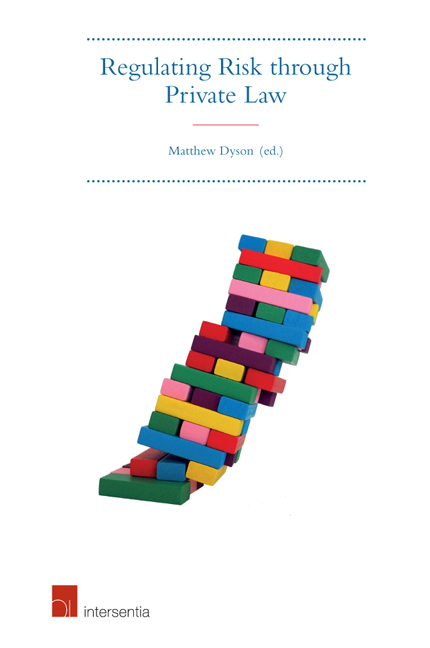Book contents
- Frontmatter
- Preface
- Contents
- Table of Cases
- List of Contributors
- Chapter 1 Introduction
- Part I Risk Overviews
- Chapter 2 Risk and english tort law
- Chapter 3 Risk and French Private Law
- Chapter 4 Risk in Swedish Tort Law: Of Models and Muddles
- Chapter 5 Risk and Italian Private Law
- Chapter 6 Regulating Risk Through Private Law: The Spanish Approach
- Chapter 7 How Dutch Tort Law Responds to Risks
- Chapter 8 Risk and Chilean Private Law
- Chapter 9 Regulating Risk Through Private Law: South Africa
- Chapter 10 Risk and Brazilian Private Law
- Part II State of the national art on risk
- Index
- About the Editor
Chapter 2 - Risk and english tort law
from Part I - Risk Overviews
Published online by Cambridge University Press: 13 October 2018
- Frontmatter
- Preface
- Contents
- Table of Cases
- List of Contributors
- Chapter 1 Introduction
- Part I Risk Overviews
- Chapter 2 Risk and english tort law
- Chapter 3 Risk and French Private Law
- Chapter 4 Risk in Swedish Tort Law: Of Models and Muddles
- Chapter 5 Risk and Italian Private Law
- Chapter 6 Regulating Risk Through Private Law: The Spanish Approach
- Chapter 7 How Dutch Tort Law Responds to Risks
- Chapter 8 Risk and Chilean Private Law
- Chapter 9 Regulating Risk Through Private Law: South Africa
- Chapter 10 Risk and Brazilian Private Law
- Part II State of the national art on risk
- Index
- About the Editor
Summary
Reasoning about risk, overtly or by implication, has long been part of English tort law, particularly within the analysis of whether the defendant was at fault. But in the last half-century, risk-reasoning has, to varying degrees, also permeated the analysis of other elements of liability, such as causation and damage. This chapter has two aims. First, it provides an overview of the ways in which risk-reasoning features in the elements of liability in English tort law. Second, it aims to assess the benefits or otherwise which flow from reasoning in risk-based terms.
The chapter is structured as follows. In brief, we first consider whether riskimposition can ever amount to a legal wrong in itself, before considering the role that risk plays within basic tort law concepts, such as fault, causation and damage. Two overarching conclusions emerge from our analysis. First, risk is relevant to different elements of liability for different reasons: sometimes, it partly determines the permissibility of an act in tort; sometimes, the creation of risk is a reason of fairness which forms part of the case for imposing liability upon a person; and sometimes, it acts merely epistemically as evidence in favour of some factual proposition. Second, risk-based reasoning is normatively necessary in tort law: we cannot do without it.
It should also be noted by way of introduction that English tort law is most commonly structured according to particular causes of action: that is, discrete sets of circumstances which give rise to liability. Some causes of action require relatively specific sets of facts to exist (for example, the tort of defamation, which is only concerned with protection of one particular interest: reputation), while others are broader (for example, negligence, which is concerned with unreasonable infliction of harm in breach of a duty of care). There are then defences, most of which apply to multiple causes of action. However, there is a significant debate in England and other common law countries about whether tort law should be so structured, or whether we should focus on rights that are said to underlie the particular causes of action. Indeed, there is even a vigorous debate over whether we should call the area of law ‘tort’ or ‘torts’, the plural implying that English law is more like a collection of individual torts than it is a coherent set of principles of tort.
- Type
- Chapter
- Information
- Regulating Risk through Private Law , pp. 23 - 54Publisher: IntersentiaPrint publication year: 2018

